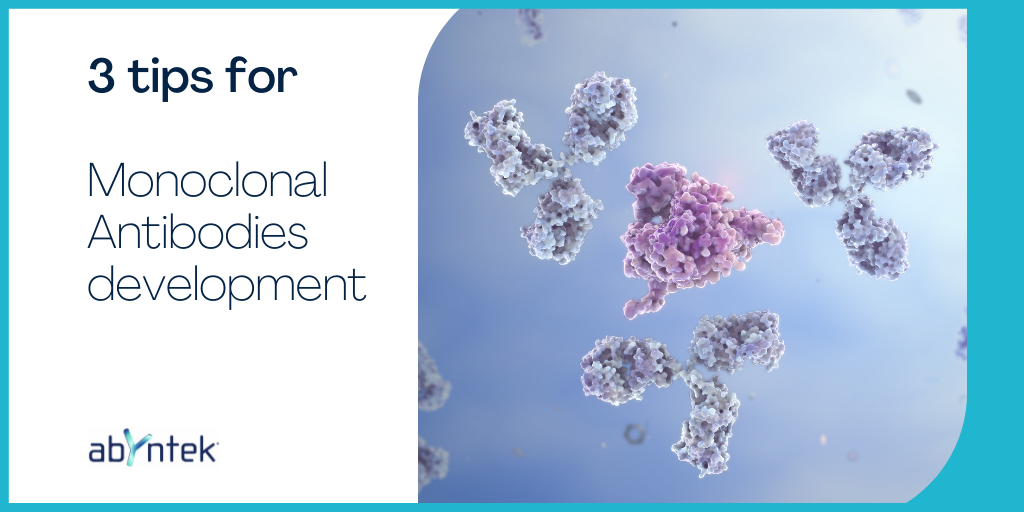Virtually all scientists use monoclonal antibodies in their research today. The process of monoclonal antibody production begins with immunization of animals with a purified protein or peptide. The spleen from the best-responding animals will then be used for hybridoma fusion. The parental cell lines generated will be subject to limiting dilutions to obtain daughter cell lines with clonal origin. The last steps consist in the purification of the antibodies present in the supernatant of the cell lines.
Importantly, for successful development and monoclonal antibody production the aforementioned steps should be carefully planned. Below we describe some tips for monoclonal antibody development highlighting key aspect that should be taken in consideration.
Do you need to produce Monoclonal Antibodies for your research?
Request your quote here
3 Tips for monoclonal antibody production
1. Antigen immunogenicity: which antigen to use?
Antigen immunogenicity is defined as the ability of an antigen to provoke an immune response. Thus, choosing well which antigen to use for the monoclonal antibody development is essential.
One thing that needs to be taken into consideration is the nature of your target molecule. As a general rule, three factors play a major role:
(1) Foreignness, to avoid that the antigen is recognized by the immune system as ´self´
(2) High molecular weight (MW), as those antigens with a MW below 1000, are not immunogenic
(3) Some degree of complexity is a better trigger for an immune response.
Additionally, some macromolecules are more immunogenic than others. For instance, lipids or nucleic acids are usually not immunogenic, unless conjugated to a carrier protein. The same applies to carbohydrates, with the exception of those that have a complex structure or are linked to a protein (glycoproteins). Given their structural complexity, proteins tend to be strong immunogens. A key aspect to take into account when using a protein for immunization is its purity, as small contamination (with bacterial antigens) might be immunodominant. In other words, the antibodies generated will predominantly be against the contaminant instead of against the desired protein.
When it comes to antigen selection for development of an antibody against a target protein, one can also use a peptide instead of a protein. The use of a peptide is recommended when your target protein is highly similar to other proteins, or difficult to express or purify. Using a peptide is also the preferred option for developing antibodies against particular post translational modification (PMT) as the number of potential epitopes available are reduced. Additionally, using a peptide as antigen reduces the cost and is quicker than using a protein. Nevertheless, one of the major limitations of using antigen peptides is that they generate antibodies that only recognize linear epitopes.
On the other hand, using proteins as antigen will induce antibodies against multiple epitopes, some of which might be conformational in nature rather than linear. Thus, anti-protein antibodies will generally perform better in immunohistochemistry and immunofluorescence applications. The caveat is that using a full-length protein might result in non-specific cross-reactivity with proteins that might contain homologous epitopes.
2. Immunization with peptide antigens: what should I know?
If you have decided to use a peptide for immunization there are few things you should consider to optimise the choice of peptide and immunization strategy. Sophisticated logarithms have been developed to evaluate various factors that can influence peptide immunogenicity. Here we summarize a few of them:
- Analysis of protein sequence and structure: knowing the protein structure, one can choose a peptide that is readily accessible to the antibodies. It is also important to avoid those peptides that might be present in closely-related proteins, such as domains, to avoid cross-reactivity.
- Peptide length: most peptide sequences will be 10-20 amino acids in length. Peptides of this sequence length are generally soluble in aqueous solutions and less likely to form secondary structures, which might not be present in the native antigen structure.
- Peptide flexibility, hydrophilicity and hydrophobicity: antibodies tend to bind epitopes found on the surface of proteins. The residues in the surface, tend to be hydrophilic, whereas hydrophobic residues are buried inside. Therefore, an ideal antigenic peptide epitope should be surface exposed and hydrophilic. As a general rule, design a peptide so that 30% of its residues are either hydrophilic or charged (lysine, arginine, glutamic acid, aspartic acid, glutamine and asparagine). Additionally, antibodies tend to bind to epitopes that show some flexibility, which is why peptide flexibility should also be considered.
- Things to avoid: peptides located in transmembrane regions or other locations within the protein that are not accessible should be avoided. Also sequence motifs, such as arginine, glycine, aspartic (RGD) motif or GTP binding sites should be avoided as they may cause cross-reactivity.
- Peptide solubility: the amino acid composition will strongly influence on peptide solubility. Hydrophobic amino acids, such as leucine, valine, isoleucine, methionine, tryptophan or phenylalanine have limited solubility in an aqueous solution. It is advised to keep the number of hydrophobic amino acids below 50%. It is also recommended that the last amino acid within the peptide sequence is hydrophilic, as this promotes solubility.
- Carrier protein: the molecular weight of the peptide itself is not sufficient to elicit an immune response. Thus, the peptides are covalently conjugated to a carrier protein. The carrier protein, as it is large and complex confers immunogenicity and therefore antibodies will be generated both, against the carrier as well as against the conjugated peptide. The two most commonly used carriers are keyhole limpet hemocyanin (KLH) and bovine serum albumin (BSA). Various crosslinking techniques can be used for peptide attachment to surface groups within carrier proteins. A common strategy is to conjugate the carrier through sulfhydryl groups, which are present on cysteine residues. Thus, if the peptide contains a cysteine residue, it can be directly used for conjugation. Of note, the peptide should not be conjugated at multiple amino acid residues and it is preferable that the attachment of the carrier occurs via the C- or N-terminal amino acid of the peptide. In accordance to this, a terminal cysteine can be added to the peptide sequence to allow conjugation of the carrier. In these cases, another decision should be made with regards to which end of the peptide should the cysteine be added, and therefore the carrier conjugated. Because, the carrier can sterically mask the predicted epitope within the peptide, it is recommended to place the cysteine on the terminus that is furthest away from the predicted epitope. With regards to the carrier used, BSA is frequently used in the development of immunoassays which allow screening of the antibodies generated following immunization. It is also used as a blocking agent and in other applications. To avoid cross-reactivity, KLH is often utilized as the carrier protein to generate the immune response. In short, different carrier proteins should be used in the immunization and screening steps to select for those antibodies raised against the desired epitope and not against the carrier.
3. Animal immunization
A decision should be made with regards to which animal species should be used for immunization. In this regard, there are few considerations to take into account. The presence of homologous proteins in that species will increase the chance of the antigen being recognized as `self´ precluding antibody generation.
Additionally, the age of the animals also plays a role in the generation of the immune response, as young adults elicit more robust immune responses than their older counterparts. Because, of this, generally 6-week-old mice and 8-week-old rabbits are used.
The injection protocol should also be designed carefully. In this regard, there are few points to consider:
- Route of injection: the choice of the route of injection will depend on the animal species to be immunized. Difference injection routes will have different advantages and disadvantages. The subcutaneous (s.c) route is typically the preferred route and most frequently used. The reason is that this route allows to monitor inflammatory processes very easily and it also allows large volumes to be administered.
- Volume of injection: the aim is to use the smallest volume that is capable of eliciting an immune response. The maximum volume that can be used will also depend on the animal species, the route of administration and the type of antigen or adjuvant used.
- Booster injections: after the immunization, antibody responses should be evaluated in blood serum to determine whether a booster injection might be required. Generally, various booster injections might be necessary if antibody titter has reached a plateau or is in decline. Boosters will be administered every 14-28 days, depending on the protocol.
If you are thinking of developing a monoclonal antibody, request your quote online
References:
Lee, Bao-Shiang et al. 2016. “Antibody Production with Synthetic Peptides.” Methods in molecular biology (Clifton, N.J.) 1474: 25–47.
Leenaars, Marlies, and Coenraad F M Hendriksen. 2005. “Critical Steps in the Production of Polyclonal and Monoclonal Antibodies: Evaluation and Recommendations.” ILAR journal 46(3): 269–79.
(Leenaars and Hendriksen 2005)
(Lee et al. 2016)




